The desire to connect with other people like us has been the driving force of queer media since the very first lesbian magazine of all time — Lisa Ben’s short-lived Vice Versa — hit the streets in the late ’40s. Vice Versa was distributed for free, by hand, from one lesbian to another. Subsequent publications had a similarly DIY ethos and distribution strategy, created covertly and cheaply by the women who could do so, in service of those who could not.
But funding these publications and creating a productive organizational strategy has always been difficult, and the vast majority of lesbian magazines shuttered within a few years of launching. Still — the sheer abundance of these periodicals, even those that only burned brightly for a short period of time, has left our community with a rich and extensively documented history. There’s also some thematic evolution going on, which exceptions but still significant. Queer publications that rose alongside feminist ones in the ’60s and ’70s were distinctly political, sharing theories on lesbian feminism, separatism and radical politics. By the late ’70s, groups who felt overlooked by the white lesbians spearheading other pubs were launching independent publications, building crucial connections on their own terms. In the ’80s, while LGBTQ+ Civil Rights activism and HIV/AIDS epidemic dominated the conversation, we also started seeing magazines with specialized focuses, like women’s music or lesbian sex. In the late 90s and 2000s, as new glossy color lifestyle magazines were launching every week in the mainstream, queers began debuting their own, hoping to stand toe-to-toe with their hetero-friendly counterparts. Then we plowed forward into the 2010s, at which time the internet was doing its quick work of connecting far-flung queers through digital spaces, and many queer pubs dialed back their print operations to go digital, or simply shut down. The internet changed everything, for all of us.
This moment feels like one in which that all might change. The dream of financially sustainable queer digital media feels increasingly out of reach in the current political climate. Anecdotally, around 75%-95% of marketing and ad spend once granted queer media has vanished. AI has cannibalized search traffic, and compromised social media platforms aren’t the referral engines they once were. Young people are getting their news from TikTok and reddit rather than legacy media. Meanwhile, so much of our entire lives have moved online, with more people working remote than ever, conducting virtual meetings all day long. There’s been a gradual push to transition more of our leisure time away from screens, and in this spirit, print is making its gradual return.
We’ve found ourselves casting an eye in the direction of print, debuting our first print issue last month, produced under the editorial eye of Kayla Kumari Upadhyaya. It’s cool to become part of our community’s rich history of community-centered print magazines.
This list is by no means comprehensive. There are hundreds more, undoubtedly, but I was looking to provide an overview of what was out there while hitting most of the major ones. It’s also specific to United States publications — but I included a few of UK and Canadian pubs in the more recent history, as they are also distributed stateside.
Much credit here is owed to Unspeakable: The Rise of the Gay and Lesbian Press in America, which was my primary source for most of this information, along with copies of the publications themselves.
Vice Versa (June 1947- February 1948)
archived by queer music heritage
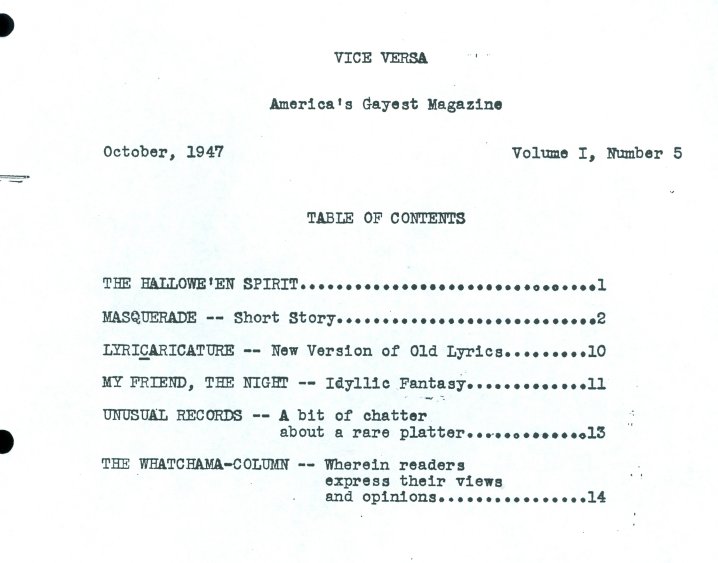
Launched in 1947 in Los Angeles, the magazine was headed up by a secretary who went by the name “Lisa Ben” and produced the magazine at the office she worked in. Ben hand-typed the magazine using a manual typewriter and created multiple copies by writing on carbon paper. Ben didn’t want to sell Vice Versa, she just handed it out to her friends with instructions: “When you’re through with it, please pass it on to another lesbian.” The mag, which mostly discussed books and music, was suspended after nine issues when Ben moved on to a different job that didn’t give her the same access to office supplies — but she never stopped writing, as discussed in Lisa Ben: Lesbian Media Pioneer, Cat Lady, and Hometown Buffet Superfan.
The Ladder (1956 – 1972)
Lesbian activist group The Daughters of Bilitis, founded by Phyllis Lyon and Del Martin, debuted The Ladder in October of 1956. The first issue included reassurances from an attorney that lesbians had nothing to fear in joining DOB or subscribing to the magazine — at that time it was still very dangerous to be “out.” It began as a 12-page newsletter of book reviews, news, poetry, short stories and DOB meeting notes distributed to 175 friends and medical professionals and eventually established nationwide distribution. A $100,000 grant floated the group for a while, but published its last issue in August/September 1972. Then-editor Barbara Grier would later note that “no woman ever made a dime for her work, and some … worked themselves into a state of mental and physical decline on behalf of the magazine.”
Focus: A Journal for Lesbians (1970 – 1983)
archived by the boston LGBTQ+ history project
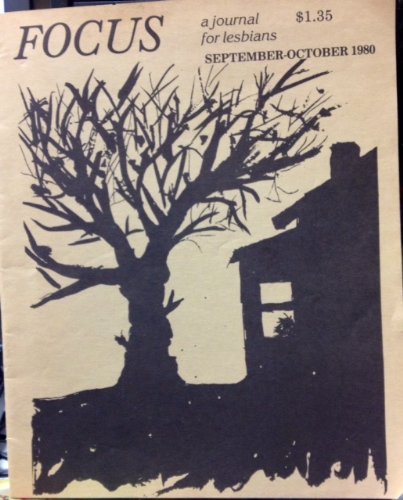
Beginning as The Maiden Voyage, the official publication of the Boston chapter of Daughters of Bilitis shifted its focus from LGBT rights to more literary material in 1977, run by five volunteers with “no office, no equipment, no files… no capital, no paid or professional help… and precious little experience.” After 13 years in business, Focus made one final plea for financial support before closing up shop, citing fatigue and “coming to grips with their financial situation.”
Ain’t I A Woman (1970 – 1974)
archived by reveal digital / independent voices
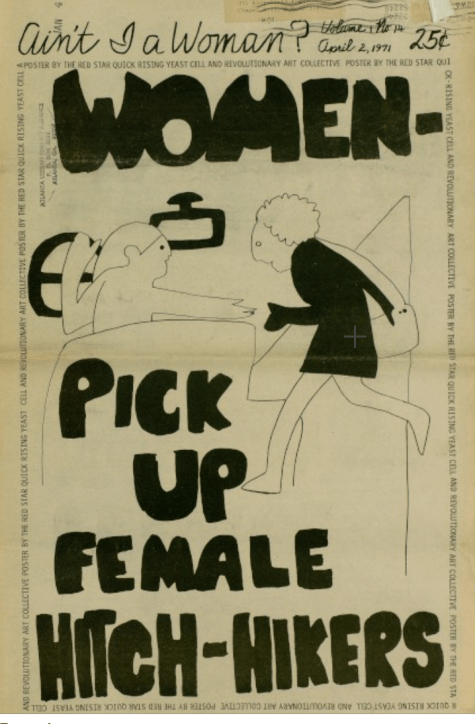
Ain’t I A Woman was headquartered in Iowa City and published bi-monthly, focusing on separatist politics, misandry, and poetry.
The Lesbian Tide (1971 – 1980)
archived by houston lgbt history

Explicitly lesbian feminist magazine The Lesbian Tide is a stand-out publication for many reasons. Birthed from the Los Angeles DOB chapter, the publication’s young radicals split from elder DOB activists in 1972 and made The Lesbian Tide entirely their own, with journalist Jeanne Córdova as editor. Her aim was to serve women how The Advocate was serving gay men. Starting with about 100 readers, by 1977 the magazine had a circulation of 3,000 and was sold in eighty bookstores. The Lesbian Tide covered a myriad of issues and topics: politics, education, butch/femme roles, motorcycle racing, lesbian music, the Goddess movement, non-monogamy and dyke separatism. They ran ads, hosted events, formed a softball team, and the staff of The Tide were key organizers of the 1973 National Lesbian Conference in Los Angeles. They forewent the “collective” structure in favor of a more traditional one, which enabled them to be “financially solvent, though by no means wealthy.” Córdova packed it up in 1980, but can proudly say she spearheaded “the first financially viable news outlet in the history of Lesbian America” before deciding she was ready for new projects, and leaving an enduring legacy behind.
Lavender Woman (1971-1976)
archived by reveal digital / independent voices
Lavender Woman is another winner of the Most Misandry award for treating the word “man” and “prick” as synonymous and telling its readers, “the male child of a lesbian feminist will become a man with the same male privilege as a boy raised to be sexist. Therefore, lesbians should give up their male children.”
Amazon: A Midwest Journal for Women (1971-1984)
archived at wisconsin lgbt history

Published in Milwaukee, Amazon included news, interviews, photos, community events, history and lots of softball-related material.
The Furies (1972-1973)
archived by duke university repository
The Furies began as a collective, initiated by twelve women in D.C. — including Charlotte Bunch, Rita Mae Brown and Joan Biren — during the spring of 1971. They began distributing The Furies: Lesbian/Feminist Monthly in 1972, throwing their hats in the ring for the cause of “challenging existing patterns of living and behavior” and “providing an articulate ideology and challenging analysis of sexism, patriarchy, and the challenges facing lesbian feminists across the country.”
In addition to herstory, political writing, social critique and anti-capitalist manifestos, The Furies published poetry by women like Pat Parker and Judy Grahn, photography by the aforementioned JEB and once even ran a piece by Gertrude Stein.
Amazon Quarterly (1972 – 1975)
archived by lesbian poetry archive
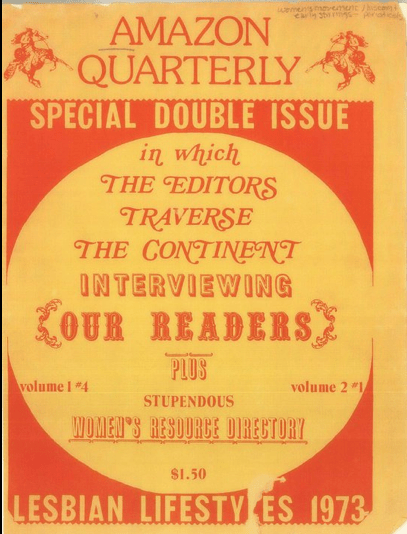
Of the 50 lesbian publications that existed in 1975, Amazon Quarterly — started by fans of The Ladder — had the widest circulation at 9,000, which enabled editors to pay their writers, but not themselves. With an intent to be “less political” than The Ladder, Amazon Quarterly published 72 pages of writing aiming to “explore… what might be a female sensibility in their arts” and give a space for “lesbians to explore whatever else is on their minds.”
Better Homes and Dykes (1972-1982)
archived by university of iowa
Produced by the Iowa City lesbian alliance, Better Homes & Dykes published editorials, community information and satirical essays. “No longer content with being in the Shadows of the Feminist Movement, much less shadows to each other,” they wrote in their first issue, “Better Homes and Dykes is for all lesbians here in Iowa City and elsewhere.”
Amazingly enough, two Minneapolis/St.Paul dykes launched a new magazine called Better Homes & Dykes in 2023, a quarterly, print-only publication containing quizzes, games, reviews, handy-butch wisdom, sports content, reader photo submissions and more.
So’s Your Old Lady (1973-1979)

Published in Minneapolis, SYOL published photoessays of lesbian volleyball players as well as a diverse range of fiction and poetry. The staff also hosted writing workshops for local lesbians.
The Lesbian Feminist (1973-1979)
The Lesbian Feminist was based in New York City and had a decidedly political bent; they were picked to publish the Lesbian Feminist Liberation’s list of demands for the Museum of Natural History’s female invisibility problem.
The Lesbian Connection (1974 – Present)
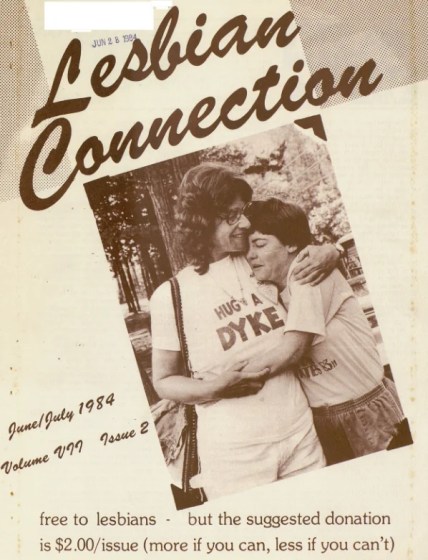
The Lesbian Connection turned 50 in 2024 — a remarkable feat. Margy Lesher began the magazine to “create a network of communication between lesbians in this country and in Canada,” a national newsletter that published every submission it received, soliciting “news of whatever lesbians are concerned with in your area — conferences, legislation, court cases, festivals, cultural events, demonstrations and lesbian resources (i.e., lesbian records, books, magazines, films, etc.) The Contact Dykes section provided phone numbers and addresses of lesbians eager to meet other lesbians passing through town. Their biggest source of income remains donations, and its office sits inside a house on a quiet street in Lansing, Michigan. Against all odds, they persevere.
DYKE: A Quarterly (1975-1978)
In 1975, two lifelong best friends in their mid-twenties launched DYKE magazine, a publication proudly against “telling the straight world what we are doing. In fact, we hope they never even see the magazine. It is none of their business. If they chance to see it, we hope they will think it is mindless gobbledegook. We are already thinking in ways that are incomprehensible to them.” They explicitly opposed men reading the magazine and they made it through six issues of “theoretical politics, live events, place, current and past history, media, fashions, music, home economics, literature, animal lore, health, applied sciences and gossip” before closing. Now its co-founder is a Zionist Trump-supporting TERF, so that’s neat.
The Lesbian News (1975 – 2022)
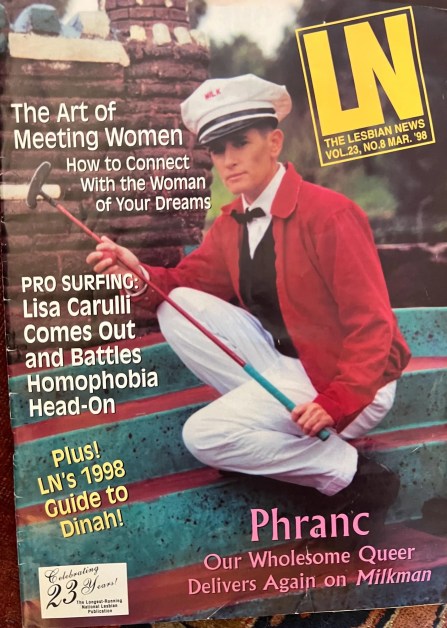
Activist, journalist and Air Force veteran Jinx Beer’s publication originally served the Southern California area and included community announcements, interviews, practical advice and reviews. She sold the publication in 1989, which eventually transformed into a glossy monthly magazine.
Salsa Soul Gayzette (1976-1985)

screenshot via For Each Other: The Salsa Soul Sisters by Alexis Pauline Gumbs vimeo
The Salsa Soul Sisters/Third Word Wimmin Inc Collective grew out of the Black Lesbian Caucus of the Gay Activist Alliance, officially splitting from the fathership in 1974 and inviting Latina women to join. The Salsa Soul Gay-zette reflected a coming together of both groups. “There was no other place for women of color to go and sit down and talk about what it means to be a black lesbian in America,” said original collective member Candice Boyce. SSS aimed to provide a political and social alternative to the discrimination and exploitation of people of color they experienced in lesbian bars.
Sinister Wisdom (1976 – present)
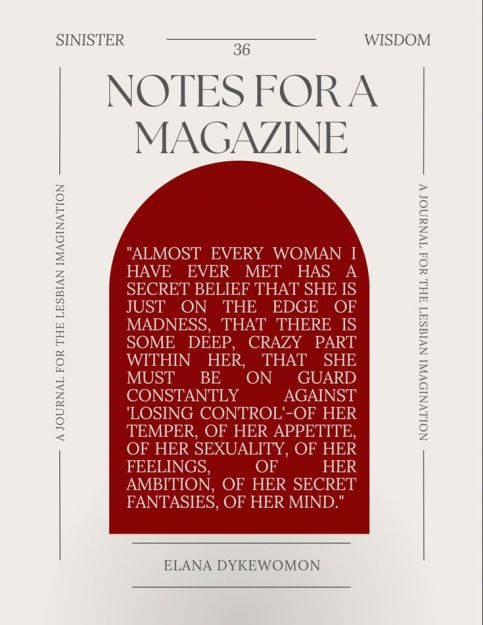
Sinister Wisdom is a multicultural lesbian literary and art journal, published quarterly, produced to manifest “the power of language to reflect our diverse experiences and to enhance our ability to develop critical judgment as lesbians evaluating our community and our world.”
The Leaping Lesbian (1977-1981)
“Leaping Lesbian in Ann Arbor, Michigan reached only a few hundred readers and survived only three years,” writes Roger Streitmatter in Unspeakable, “but it also raised the consciousness of untold numbers of lesbians to the reality that the new Right was not, in fact, right.”
Tribad: A Lesbian Separatist Newsjournal (1977-79)
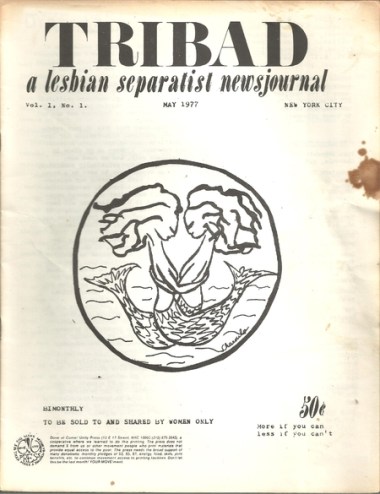
Tribad‘s legacy includes a frank and honest look at lesbian sexuality and its open critique of mainstream feminism’s focus on white women and exclusion of issues important to women of color. Tribad published drawings of nude women, called for “armed combat to overthrow the white male dictatorship” and promoted the idea of lesbian-only communities.
Azalea: A Magazine by Third World Lesbians (1977-1983)
“An enormous need exists for 3rd world lesbians to communicate among ourselves,” declared the editors of Azalea, who’s editorial policy was to publish whatever they were sent, without editing, and pay in magazine copies. Azalea was also birthed out of The Salsa Soul Sisters/Third Word Wimmin Inc Collective.
Pearl Diver (1977-1978)
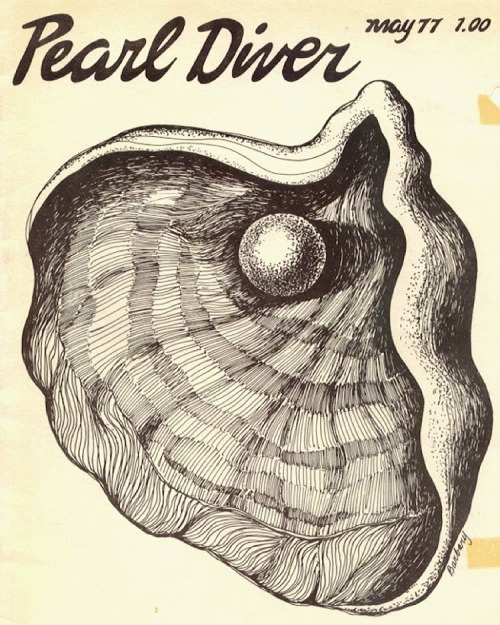
via herstory
Published out of Portland, this Black lesbian magazine declared itself “a public meeting place for open discussion — a blank page for the lesbian community to share the interests and issues, communication, analysis and news of our lesbian lives.”
Common Lives/Lesbian Lives (1981-1996)
archived by reveal digital / independent voices
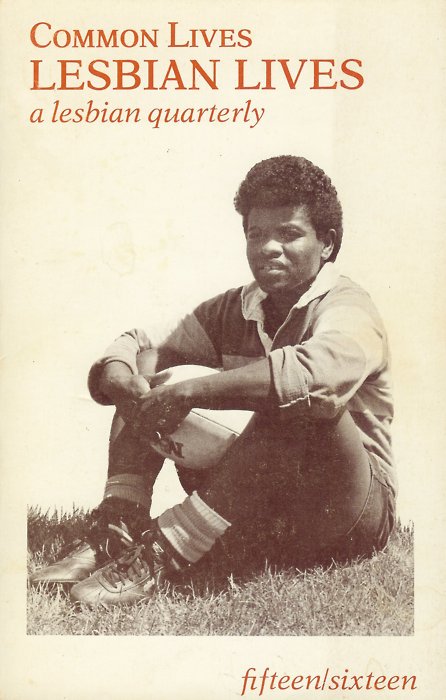
Yet another publication out of Iowa City, CL/LL was a collectively produced publication who focused on presenting a diverse range of voices launched by eight lesbian friends who fled Los Angeles for the midwest in 1980. At its peak, CL/LL boasted 2,500 subscribers, and shut down when its distributor, Inland, declared bankruptcy and the mag was unable to raise enough financial support on its own.
Big Apple Dyke News (B.A.D News) – (1981- 1988)
one issue archived on lesbian poetry archive
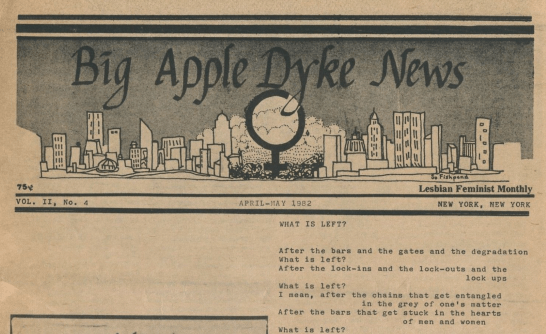
B.A.D. boasted an anti-establishment ethos and was known at the time for being the most committed to tracking the AIDS epidemic. It was stricter about the quality of its submissions and was one of the first LGBTQ publications to syndicate AP or Wire stories. Based in New York and lacking a budget to send reporters cross-country, B.A.D. prioritized bringing its readers all the relevant news on LGBT Civil Rights issues over ensuring all its voices were gay ones.
ONYX: Black Lesbian Newsletter (1982-1984)
archived by lesbian poetry archive
This newsletter was one of three Bay Area publications devoted to black lesbians within the past two decades. Issues included poems, drawings, political perspectives, book reviews, photographs, event listings, personals and business listings.
On Our Backs (1984-2006)

Screenshot
In the ’80s, a divide rose up in lesbian culture and the press between those we’d now label “sex-positive” and lesbian feminists who were against practices like BDSM, using phallic sex toys and watching/making porn. On Our Backs was on the pro-sex side when it became the first-ever women-run erotica magazine. The title was a nod to off our backs, a feminist magazine that was not as “sex-positive.” On Our Backs featured fiction, non-fiction and photography of a diverse range of women, with writers like Dorothy Allison, Jewelle Gomez, Sapphire, Susie Bright, Patrick Califia, Tee Corinne, and Joan Nestle. I picked up my first copy two years before it ceased publication altogether! “We taught the world how to use a strap-on,” Susie Bright revealed in her “short history” of the magazine. “We made sex fun and smart for women, something that was entirely in a female self-interest. It went way beyond homosexuality, it was really feminist sex liberation.” They went bankrupt in ’96, were purchased by lesbian-owned H.A.F. Publishing in ’96, began re-publishing in ’98, and closed for good in 2006.
Hot Wire Journal (1984-1994)
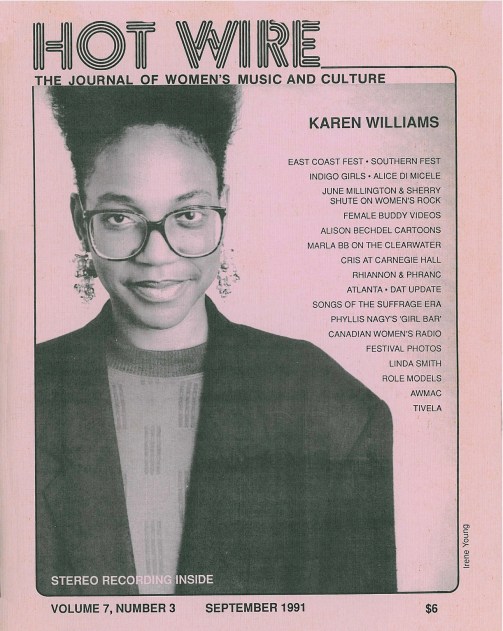
Described as “the essential publication to read during the 1980’s and 90’s” which “reported on and documented a movement and an era,” Chicago-based HOT WIRE launched in 1984 — their debut issue featured comedian Kate Clinton — and raged on for ten years under publisher/editor Toni Armstrong Jr., with subsequent cover stars like Alix Dobkin, Alice Walker, Alison Bechdel, Audre Lorde, Cris Williamson and Holly Near. The magazine specialized in “women-identified music and culture, primarily the performing arts, writing/publishing, and film video,” reflecting the importance and centrality of the Women’s Music Movement to lesbian culture during that time. The front-of-book section HOTLINE functioned like a lesbian craigslist — announcing recipients of grants, providing info on how to help a lesbian couple whose house recently burned down to the scoop on political and social actions, bookstore openings, publications, films, and local meet-up groups for various special interests.
When Toni Armstrong launched the magazine, she committed to producing it for no less than ten years, and when those ten years were up she made the tough decision to close the publication — citing a need for time, money and sleep and also her “acceptance of the fact that we’re nearing the end of an era.”
Dykes, Disability and Stuff (1988 – 2001)
archived by the glasgow women’s library
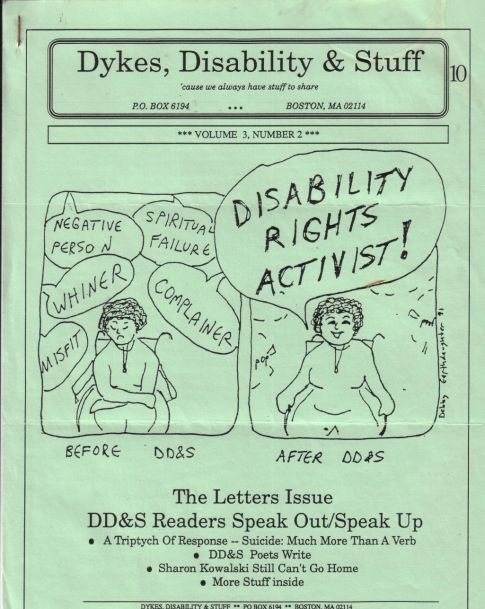
via women’s library
This newsletter was the first to focus entirely on the needs of lesbians with disabilities, publishing art, news, opinion and prose as well as crucial health and wellness information. Efforts were made to make it as accessible as possible, with editions published in audiotapes, large print and Braille.
OutWeek (1989-1991)
gay + lesbian magazine

OutWeek is the one of three publications I included on this list that were not just for women — but it’s included here because it’s basically the only publication in LGBTQ history to always make a concerted effort to devote equal space to women’s and men’s issues, even when doing so hurt sales. The magazine was edgy, radical and progressive, with close ties to AIDS activist group ACT UP and practices like using the word “queer” and outing gay and lesbian celebrities. Allison Bechdel’s Dykes to Watch Out For debuted in OutWeek. This envelope-pushing didn’t win over many advertisers, though, so the publication was short lived.
BLK Magazine (1989 – 1995)
gay + lesbian magazine
archived at the national museum of african-american history & culture

And now we arrive at the other major publication on this list that was not just for women, included due to its importance in the Black queer community specifically, beginning as a 16-page black-and-white newsletter with a circulation of 5,000 to its final form as a 40-page magazine with paid subscriber base, advertisers and global distribution to 37,000 people. Editor Alan Bell set out to create “a Black magazine for gay people and not a gay magazine about Black people.”
Aché (1989 — 1994)

This free publication by and for Black lesbians in the San Francisco Bay Area transformed from a publication to a real community that gave its readers an ability to share resources, publish creative work and build connections.They hosted events — lectures, dances, rent parites — hoping to avoid the underfunded destiny of all lesbian magazines. Co-founder Lisbet Tellefsen documented every aspect of the publication, creating an archive of the magazine itself but so much more: grant applications, event flyers, photographs, notes from meetings and planning sessions.
Anything That Moves (1990-2002)
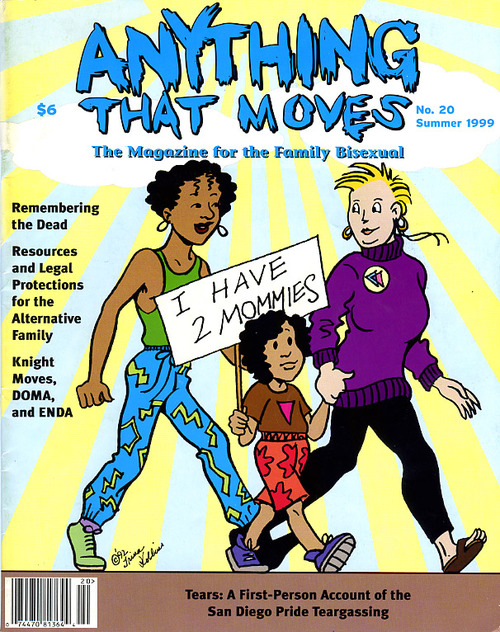
This is the final publication on this list with a readership that included men and women. Published quarterly by the Bay Area Bisexual Network, this non-profit publication staffed by volunteers was for bisexual men and women. Themed issues focused on topics like Sex Work, Trans-Bi relations and Families, featuring work from a variety of genres. They stopped updating their website in 2004.
Girljock (1990 – 2006?)

Girljock started out as a small photocopied fanzine from a girl who “imagined a magazine that would discuss a mixture of sports, questions about being a lesbian athlete, questions about being female in the masculine sporting universe, crushes on the field, and more.” Her manifesto announced, “Fuck the Well of Loneliness, Goodbye to all that. We’re here to have fun.” After a positive write up in the San Francisco Weekly, Girljock took offf, eventually becoming a full-sized color-cover magazine distributed by a large company who apparently had significant advertiser interest, too. A Girljock anthology was published in 1998, and although I can’t find evidence of any print issues existing beyond that point, their website was most recently updated in 2007.
Lesbians on The Loose / LOTL (1991 – 2019)
based in australia

LOTL was Australia’s most read lesbian magazine by the end of the ’90s, with a circulation of 20,000 copies per issue. The magazine’s evolution is pretty fascinating to trace through its archives. It begins as a scrappy, black-and-white newsletter style pub with cover stories about lesbians at Mardi Gras, the Gay Games and hate crimes legislation. Its design and layout gets a little slicker and more colorful before becoming a full-fledged glossy in the mid-90s, with a mix of “real people” and celebrity covers. By the 2010s, celebrities grace the majority of covers and they merged with Curve, often sharing cover stories. Its final print issue featured the queer stars of The L Word: Generation Q.
Black Lace Magazine (1991 – 1992)

This spin-off from Black Gay & Lesbian magazine BLK was focused specifically on black lesbian sexuality. Its four issue run was still a landmark moment, launched, according to its editor, “AFTER TOO many late night and early morning conversations and political debates and asking should I? Or shouldn’t I? And worrying about the devastating infinite measurements of political ‘correctness’ and meditating on what it means, feels like to be an African American lesbian loving other African American lesbians, sex and multiple orgasms.”
Curve Magazine (1991 – Present)

My extensive collection of Curve magazines reflects many years of dedication to this lesbian glossy, with its gossip and advice and travel pieces and celebrity interviews — it was the closest thing I could find to the mainstream women’s mags I read before coming out, and it was a formative read for me as my life plowed forward in the direction of eventually starting Autostraddle. With its entire archives now accessible online, Curve remains in print, with a digital archive that provides “a portal into the hard-won lessons from our past that can inform our actions into the future.”
Girlfriends (1993-2006)
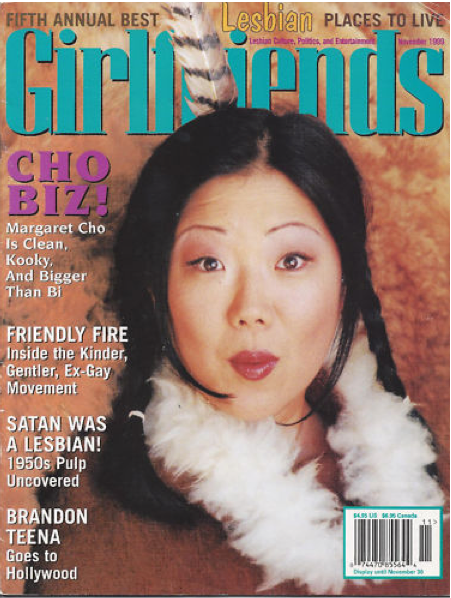
Girlfriends, 1999
Curve Magazine, one of the few lesbian publications still in print, launched in 1991 (as “Denavue”), and Girlfriends arrived three years later as “the magazine of lesbian enjoyment” and, later, “the word on lesbian lifestyle.” Started by a group of On Our Backs writers including Heather Findlay, the magazine was funded by Findlay’s mother but began turning a profit in 1998. Theme issues focused on topics like relationships, sex or gay pride, with a focus on the lesbian popular image. It ceased publication when it was sold to Underground Networks Inc along with its “naughty little sister,” On Our Backs, in 2006. The intention was to shift operations online, but that never came to pass.
Fat Girl Zine (1994 – 1997)
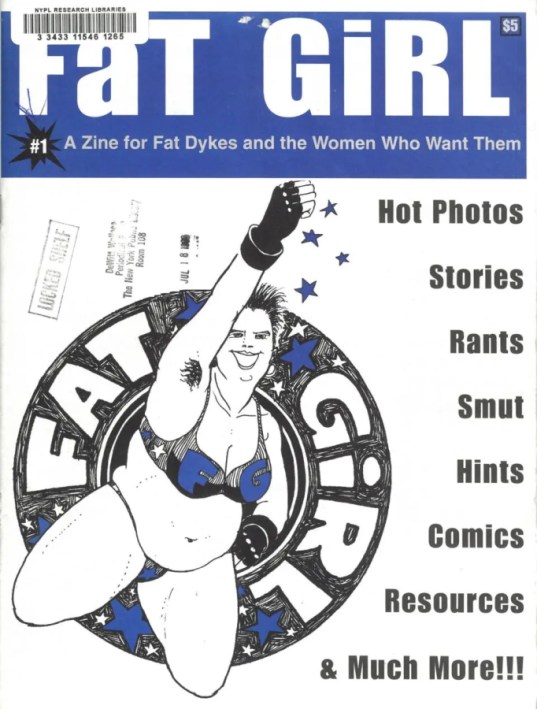
Created by a grup of queer fat dykes in the Bay Area, Fat Girl Zine reflected a frustration with the way mainstream queer women’s media sidelined the political issues, bodies and lives of fat people. “FaT GiRL was unlike anything the queer community had seen before,” writes Rose Gelfand,” and though not without sizable controversy or pushback, they were embraced phenomenally.” The pub included articles, manifestos, erotica, centerfolds, roundtables and info on community events.
Diva Magazine (1994 – Present)
based in the UK

While this list is focused on American magazines, Diva is well-read in the states as well. Often a bit edgier than its stateside counterparts, DIVA is a glorious glossy that advertises itself as the world’s best-selling magazine for LGBTQIA+ women and non-binary people. It’s got the sheen and breadth of a mainstream mag. Its most recent issue, the Butch issue, includes a history of legendary club night Butch, Please!, interviews with G-Flip and an essay on the glory of stud friendship.
Venus (1994 – 2007)
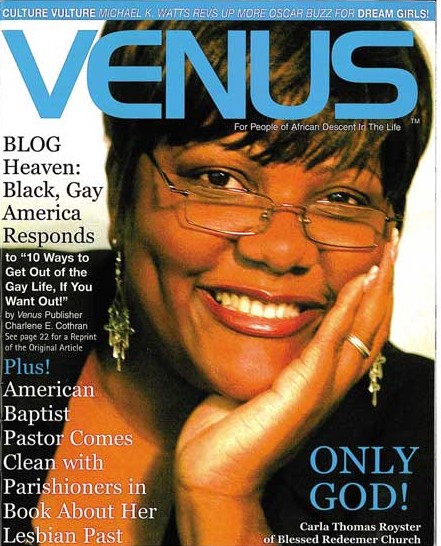
Unfortunately I couldn’t find an image of the magazine from before the switch
This magazine didn’t close in 2007, but it did something much worse — subscribers got a big surprise in 2007 with a cover story featuring publisher Charlene E. Cothran and her story entitled ‘Redeemed! 10 Ways to Get Out of “The Life” if You Want Out!” The next issue had another cover story on a “former” lesbian, Carla Thomas Royster. Rev. Irene Monroe, who had written for the publication before it made a deal with the ex-gay devil, lamented that, “Venus magazine was the first and only queer magazine owned and operated by a black lesbian that spoke to and about the unique intersections of being black and LGBT in both the African-American and white queer communities.”
She Magazine (1999 – 2015)
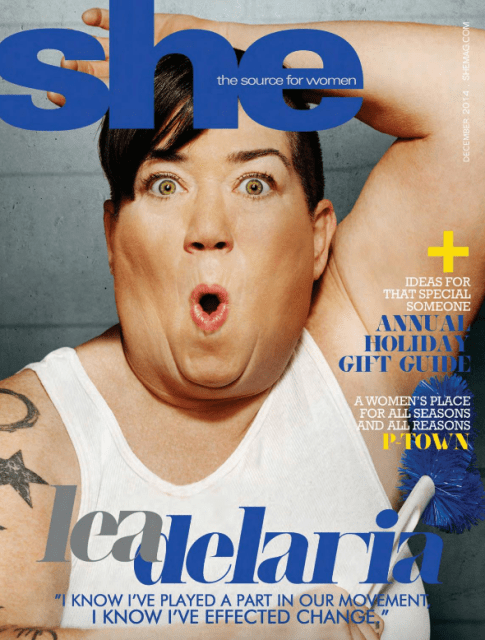
Florida’s longest-running lesbian magazine was a glossy with celebrity covers and a whole section dedicated to Spanish language content.
Issues: The Magazine For Lesbians Of Color (2000 – 2002?)
This Oakland-based publication described itself as “Stylish, sexy and smart…everything that you are, we are.” It’s unclear when the magazine stopped publishing, but its former website has been taken over by Jews for Jesus.
GO Magazine (2001 — )
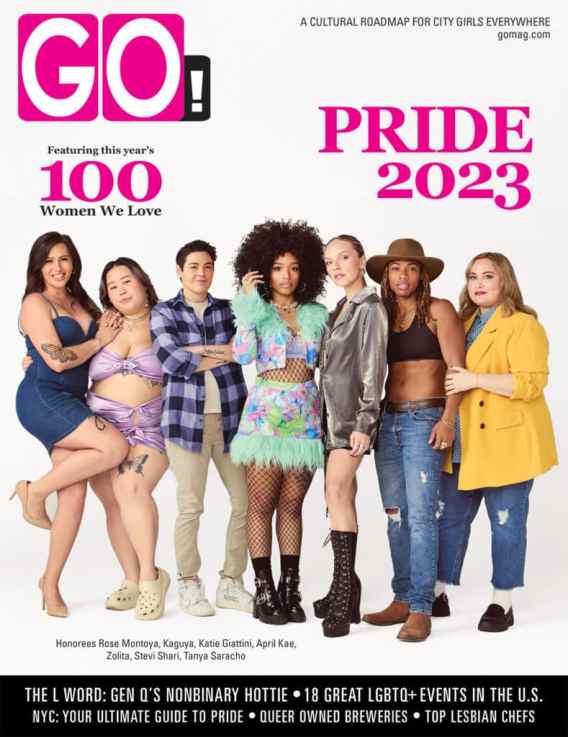
Go Magazine was THEE publication for New York City dykes when I lived there — publishing travel guides, lists every power lesbian wanted to be on, interviews with the celesbians of the moment and serving as the holy grail of nightlife listings. As the nation’s most widely read free lesbian publication, distributed in 25 cities across the U.S., GO keeps on going strong all these years later in print and online, heralded as “the cultural road map for the city girl.”
Velvetpark (2002 — present)
in print 2002 – 2007

Founded by Grace Moon, Velvet Park began as a 48-page biannual print magazine focused on “the culture and arts of lesbian, dyke, butch, femme, and women identified queer and transpeople. While the magazine shuttered its print edition in 2007, it continues to exist online.
Jane and Jane Magazine (2006 – 2009)
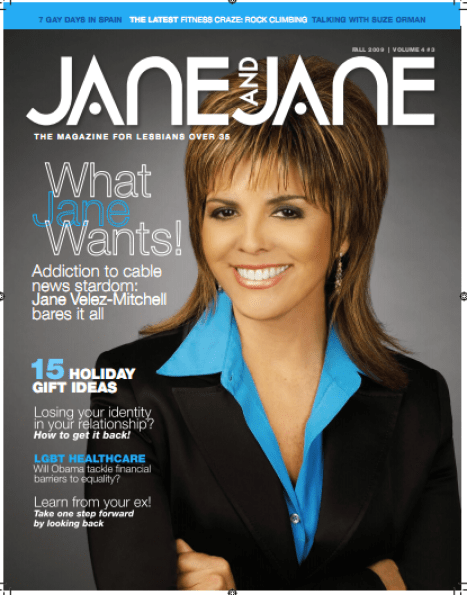
This “home and family” magazine for lesbians over 35 covered topics including parenting, relationships, health, travel, financial planning and cuisine. They steered clear of “weighty issues,” telling The Sacramento Bee in 2007, “we’re still very supportive of gay and lesbian causes, but we have to do it in a way that fits with our (magazine’s) mission.”
Bound Magazine (2009—)
Sydney-based publisher Avalon Media debuted its first issue of this mag that promised “different culture, same lifestyle” and the claim it’d be the first “international lesbian magazine” featuring celebrity interviews, travel editorial, fashion and lifestyle news.
Elixher (2011 – 2017)
In print 2011 – 2014
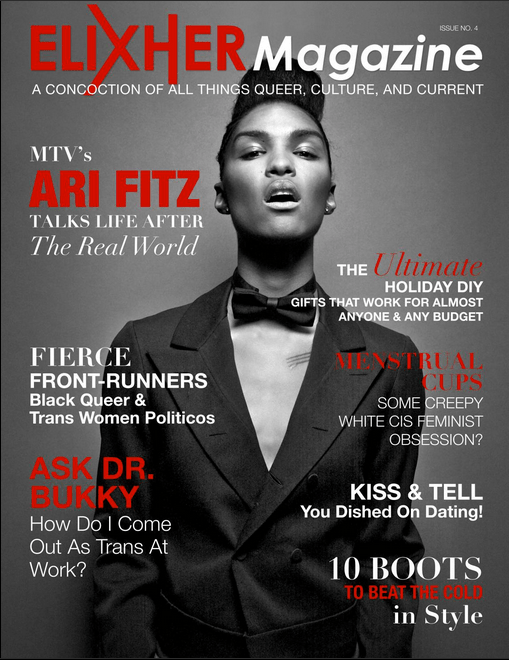
Another publication I miss dearly from our earliest years of Autostraddle is Elixher — a digital and print publication created for and by Black lesbian, bisexual and trans women and their allies. Its print edition lasted four issues, with cover stars including Ari Fitz, Janet Mock and AZ Marie.
Tagg Magazine (2012— )
In print 2012 – 2023

Founded by Eboné Bell in 2012 and eventually expanding from its original Washington, DC focus to a nationwide audience, Tagg published its print edition until going fully digital in 2023. Sondra Morris bought the company in 2024, where she serves as Editor-in-Chief,
LSTW (2016 – Present)
based in canada
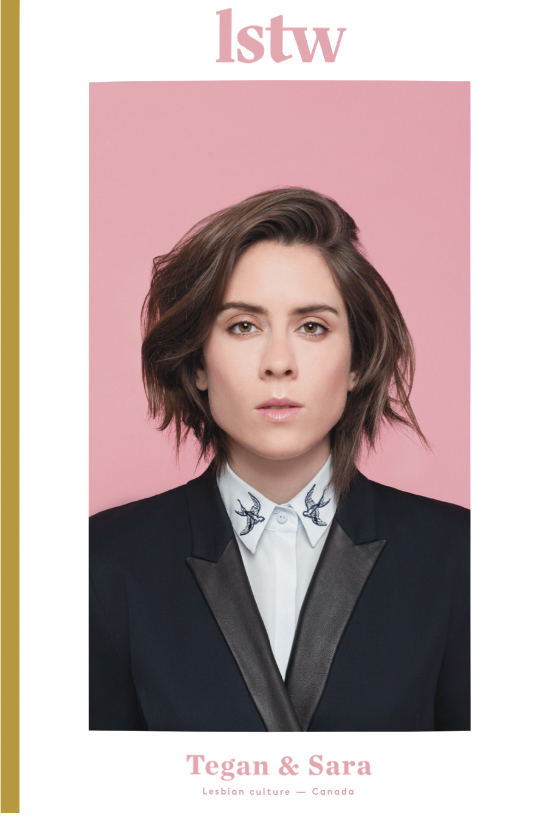
This bilingual, artistically driven print magazine aims to defy stereotypical portrayals of LGBTQ+ women and give greater visibility to positive role models. Published in Montreal and Toronto, LSTW is a gorgeous piece of media distributed in 20 cities in North America and Europe.
BUTCH Is Not a Dirty Word (2016 —)
based in australia
In print 2016 – 2023
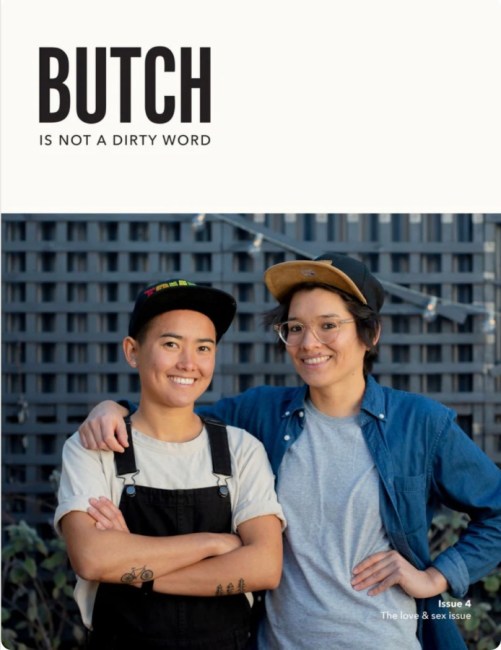
Butch Is Not a Dirty Word began as a project for founder Esther Godoy to process the anger and pain she felt growing up butch, told she wasn’t worthy of community or care. She asked friends who loved butch lesbians to write essays about why they loved butches, paired them with photos of butches from Australia and the magazine was born into a gorgeous biannual print product. Its mission remains to celebrate butch identity, increase butch visibility and amplify butch voices.
Skirts SoFlo (2023 —)

Screenshot
Founded by three friends in South Florida, Skirts SoFlo’s mission is to shine a spotlight on LGBTQ arts, literature, music, food and business while uplifting and connecting their South Florida women’s community.
Autostraddle (2009 —)
In print 2025-—
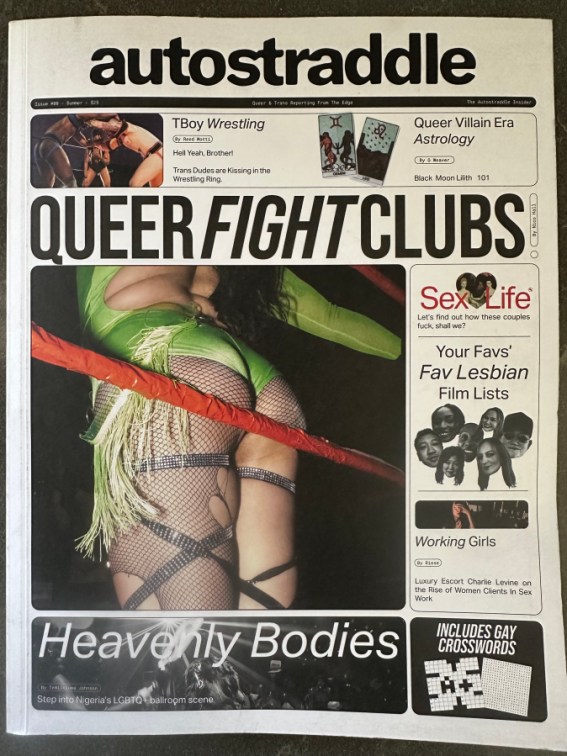
We’ve made a few small forays into print publishing in the past, like the five-issue The Better Together ‘zine series with Everyone is Gay, and the Behind The Scenes Zine of 2012 (which was created by Riese, Laneia and Rachel and contained collages and g-chats and other Autostraddle ephemera). But the publication of the Autostraddle Insider — edited by Kayla Kumari and with a cover story by Nico Hall — is our first full-size full-color print magazine. Things feel very uncertain these days, but this magazine feels like a bit of hope in our hands, and hopefully is just the beginning.


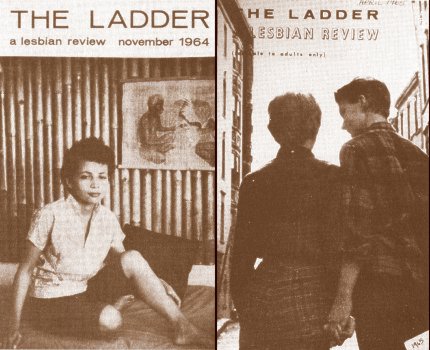
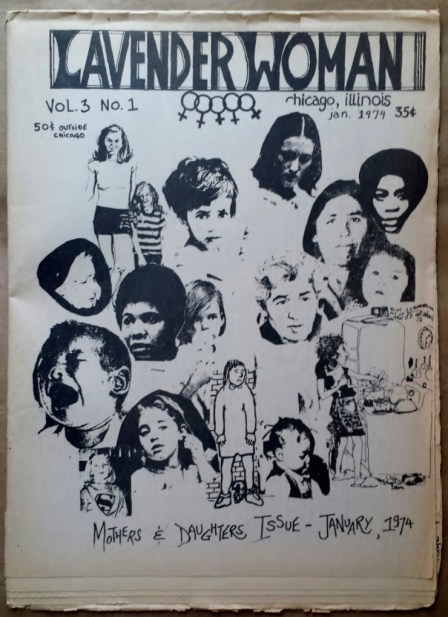
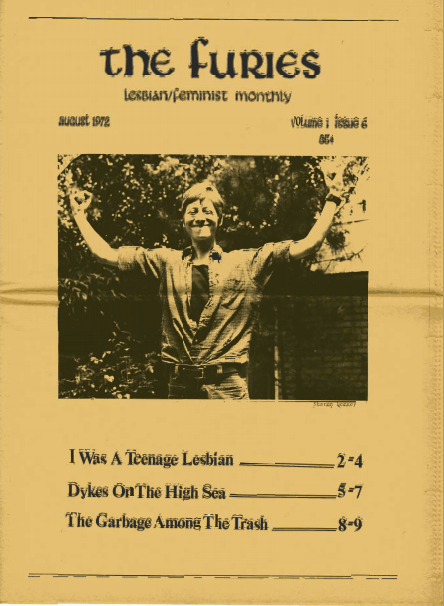
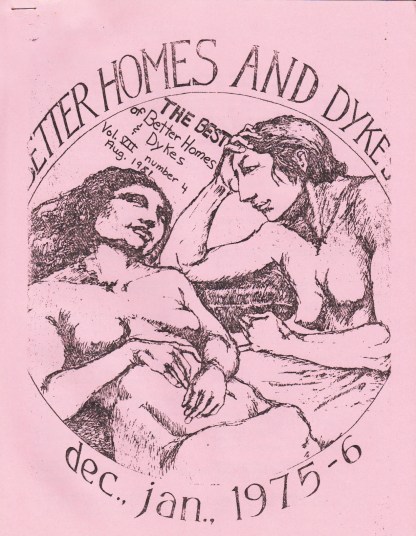
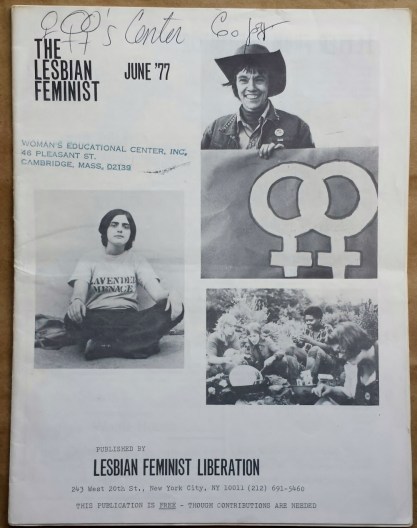
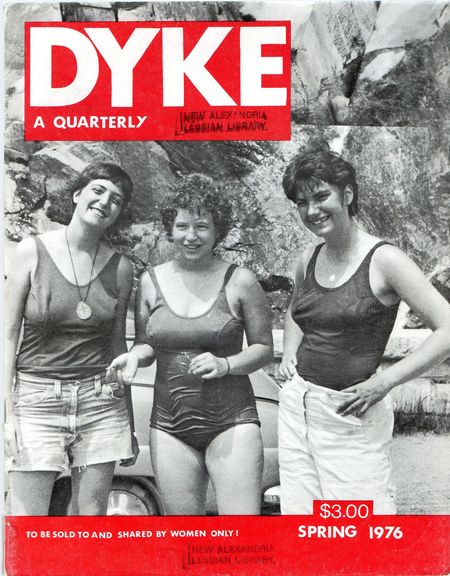

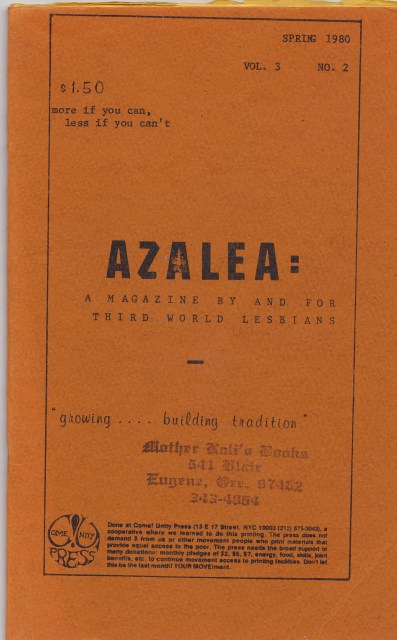
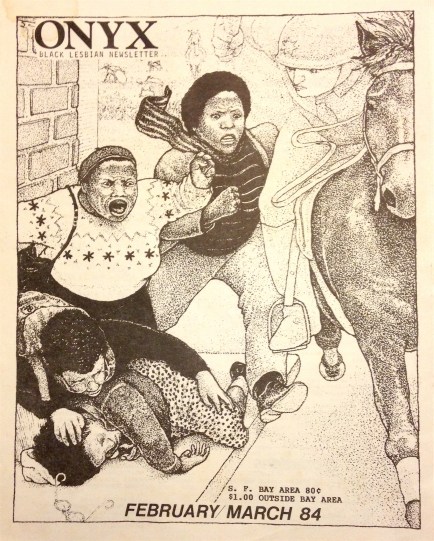
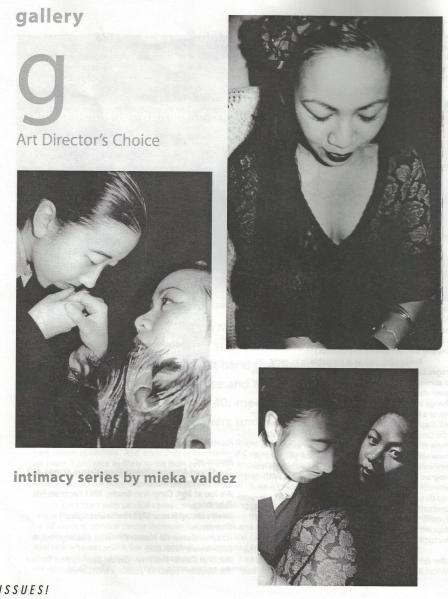
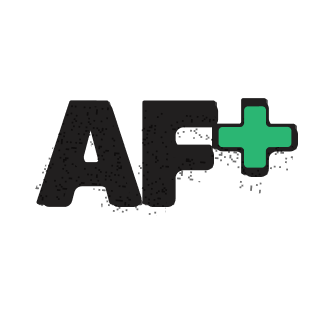
Incredible list! These are the kinds of well-researched things that I truly appreciate on AS. Thank you for your time putting this together.
thank you sally!
Oh man, I forgot about LOTL! I think they used to have it for free at bars and the youth health clinic.
Thanks, this is so good.
oooh diva!! surreptitiously reaching for the one copy at the bookstore and squirrelling it away at home to read and dream about a future gay life with other actual gay people…
Fun fact: my Dad found out I was gay when he was cleaning up after a leak in the roof and water got into the drawers where I was stashing all my illicit Diva magazines.
And then he said nothing about it for YEARS
ahahah aaw sally! thats a great fun fact. homophobic water damage…
So eye opening to see how far we’ve come and remember the queers that DID exit before us